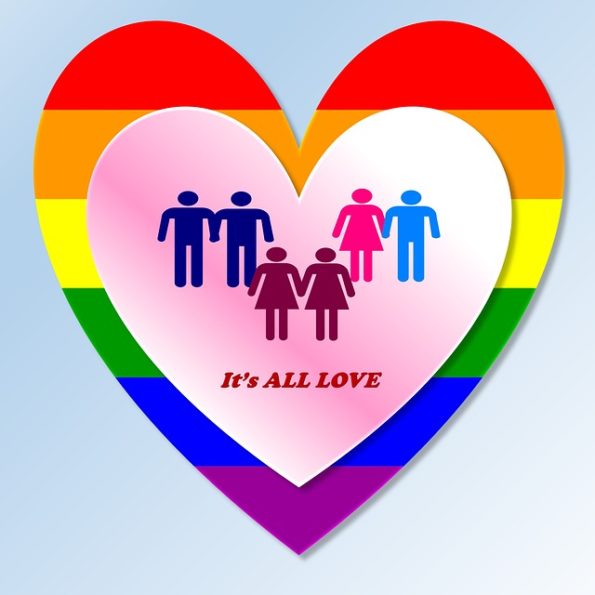After I came out to my family, I prepared myself to come out to my friends as well. But I always had this worry that they wouldn’t want to be around me because I’m different. They wouldn’t want to be around me because it would be too weird. They wouldn’t want to be around me because I’m not normal. Yes, I am a girl who likes girls. Yes, this makes me a minority of the population. But even though many think this, I am not a deviant byproduct of some genetic malfunction. I didn’t slip away from what some call the ‘default sexualtiy’. I am a lesbian woman, and it is normal.
What is Heteronormativity?
According to Juniper Russo, heteronormativity can be seen as the thought that being cisgender (describes someone whose gender identity matches that of their gender assigned at birth) and heterosexual is the normal state for a human.

As a result, this causes members of the LGBTQ+ community to feel as if they aren’t supposed to feel how they do, or that something is wrong with them. Obviously, it is a big problem when a portion of our population feels disconnected to the rest. Even though there are many supportive LGBTQ+ groups and members within the community, these individuals deserve to connect with those outside of the LGBTQ+ community and bond our society. To do this, we must break down the barriers of heteronormativity and bring unity to this space in our culture.
However, there is definitely a big difference between homophobia and heteronormativity. This means that some things associated with heteronormative qualities should not have an automatic negative connotation around them. As explained in an article from Faith Permeating Life, homophobia addresses members of the LGBTQ+ community in a negative way, while that is not necessarily the case with people in the heteronormative mindset.
[perfectpullquote align=”full” bordertop=”false” cite=”” link=”” color=”” class=”” size=””]However, there is definitely a big difference between homophobia and heteronormativity.[/perfectpullquote]
Is it always a bad thing?
As explained an article from Good Therapy, heteronormative assumptions don’t necessarily come from ill intentions. There are many people who support progressiveness for the LGBTQ+ community that, for example, can’t help but to think of their children as nothing different from hetersexual and cisgender. So this doesn’t necessarily mean that they would ever want to convert their child if they did come out as LGBTQ+.
And I can definitely speak to this. The day after I came out to my mother, we were sitting in the car together waiting to meet up with my aunt. We started talking once more about how long I had felt this way towards girls and she made it very clear that she will always love me no matter what. But then she started crying. I asked her why and she proceeded to explain to me that she always had a vision of me when I’m older and happily married and have children of my own that look like me. The only reason she was crying was that it was hard for her to adjust that picture. But she remembered that there are ways for me to have a child that looks like me. But so much of what she had imagined for close to 15 years was just…different. So I get it. People assume. I don’t blame them for it.

But we all need to expand our minds because there are always going to be LGBTQ+ members and it would help all of them if the chains of heteronormativity were broken down. And an essential part of all of this is to remember, as Meg-John Barker states in their article, “Challenging heteronormativity is not about challenging heterosexuality. It is about questioning the idea that heterosexuality is the only normal, natural, or good form of sexuality.”
LGBTQ+ Sex Education Within Schools
Another problem that comes from heteronormativity is the system that schools have regarding sex education. According to an article from the New York Times, only 5% of LGBTQ+ members claimed to be taught positive information about LGBTQ+ issues in their health class. This makes them 5 times more likely to look up sexuality information online than their classmates who are not a part of the LGBTQ+ community. This is a big problem because gay students can go into their adult life not knowing safe homosexual sex habits. Even though there are statistically less students in each classroom that identify as LGBTQ+, it is simply unfair that they aren’t getting taught material that is essential to them.
If the heterosexual students are taught sex education that lines up with them, why shouldn’t the homosexual students get the same treatment? As stated in the same previous article from the New York Times, one place where this gets out of hand would be in Alabama. Many classes in Alabama must emphasize the point that being gay is an unacceptable “lifestyle” to display to the general public. Making those young LGBTQ+ individuals feel wrong is an absolutely awful thing to be happening in schools.
Heteronormativity in Film

One simple way to lessen the effects of heteronormativity could be to include homosexual characters in Disney or Pixar movies. An article from Science Daily shines a light on the fact that “In the world of Disney, falling in heterosexual love can break a spell, save Christmas, change laws, stop wars and even, in the case of The Little Mermaid, cause an individual to give up her personal identity.” And if you think about it, all of the princesses have a what? A prince. And I can say that growing up and watching these movies, it never really made sense to me how the girl was always with a guy. I couldn’t pinpoint why I always felt so unsure about it, until I grew up and came to terms with my sexuality. And I know now that it is not okay for young children to feel alone and confused like I did.
[dropcap][/dropcap][dropcap][/dropcap][perfectpullquote align=”full” bordertop=”false” cite=”” link=”” color=”” class=”” size=””]And if you think about it, all of the princesses have a what? A prince.[/perfectpullquote]
And yes, I know what some of you are thinking: ‘But if there are gay movie characters then it will influence all of these kids to be gay too.’ I won’t lie, I’ve thought about that. But then I remember that I grew up my entire childhood only seeing straight characters in movies and on T.V. Yet I’m still a lesbian. So my question to you is, why wasn’t I influenced by the straight characters in the shows and movies? Because it never has been, and never will be something I can control. It’s as simple as that.
This has been affecting kids for a very long time. As explained in an article by Dodai Stewart, 30% of kids ages 3 and under have a T.V. in their bedroom, and this number increases as the children get older. This means these children are being shown that homosexuality is abnormal and needs an explanation. So if LGBTQ+ members can’t change who they are, why not make this whole spectrum of sexuality be something that can all be seen as acceptable and normal?
Conclusion
Heteronormativity is something that affects young members of the LGBTQ+ community in a very negative way. Ultimately, our society needs to change its outlook on being LGBTQ+ to be just as normal as being heterosexual and cisgender. It will definitely take time to adjust for many people, but there are some solutions, like bringing gay movie characters to Disney, and talking about LGBTQ+ sex in health classes. Helping this community thrive is something each and every one of us need to pay attention to.
We’re all normal. It just takes a open mind to see us as we are.
Photo by Ashley Williams from Pexels
